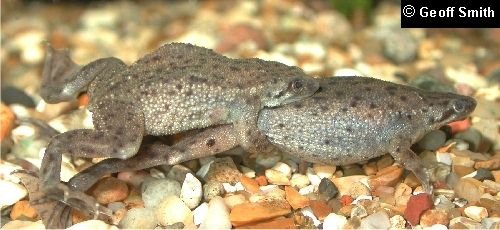BREEDING THE AFRICAN DWARF CLAWED FROG |
| A pair of Hymenochirus frogs in amplexus. |
Hymenochirus boettgeri is a totally aquatic frog, brown in colour and about 4cm in length. It belongs to the Pipidae family and is native to Cameroon, The Central African Republic, The Democratic Republic Congo, Equatorial Guinea, Gabon and Nigeria. These frogs are commonly available through the tropical fish trade and can be distinguished from juvenile Xenopus by their webbed forefeet.
They are easily maintained in an aquarium at a temperature of between 21°C and 25°C. I acquired four specimens in May 1984 and they were fed mainly on Tubifex worms with occasional Bloodworms (Chironomid larvae) and Daphnia.
For breeding purposes a trio of frogs was accommodated in a 61cm x 30.5cm x 30.5cm aquarium containing dechlorinated tap water to a depth of between 8cm and 1Ocm. An aquarium heater/thermostat maintained the water temperature at 21°C and coconut shells with Water Moss (Fontinalis antipyretica) provided shelter at one end of the tank. No filtration was provided.
Egg laying occurred on eight recorded occasions between 29 September 1986 and 29 October 1986. During this period the frogs were moved to different tanks. Sometimes the tanks were illuminated and other times not. Photoperiod did not appear to affect the regularity of egg laying. The only significant factor for successful egg laying appeared to be water depth, which did not usually exceed 1Ocm.
Breeding occurred at night and was always preceded by the male standing on the “fingertips” of all four limbs on the floor of the aquarium where he called by emitting a short series of buzzes and attempted to clasp any frog that came near. When a receptive female approached his clasping succeeded and egg laying subsequently occurred although on one occasion not until approximately two hours later.
The frogs swam to the water surface, turned upside down, laid between approximately 3 and 6 eggs then swam to the bottom again. This process was repeated over several hours and once continued into late morning of the following day. The total number of eggs laid each time appeared to vary but was usually hundreds. Egg laying occurred at intervals of between two and seven days. Breeding activity was most intense between the 23rd and 29th October with three egg batches in just seven days.
The problem of predation on the eggs by the adults was minimised by siphoning a large number of live Daphnia into the tank the day after eggs were laid. This served to distract the frogs’ attention from the eggs.
The tadpoles developed after two days and were transferred to an 8.5 litre square plastic bowl where the temperature was maintained at 24°C. Four days later they began actively swimming and feeding. The tadpoles are entirely carnivorous throughout their development and, because of their tiny size, require microscopic animals on which to feed during the first few days. A constant supply of micro-organisms was maintained by keeping a few Water Lice (Asellus aquaticus) in a jar of water where they were fed on flaked fish food. Water from the jar was transferred to the tadpoles (1Oml to 20ml per day) using a syringe.
Four days later the tadpoles were large enough to be fed freshly hatched brine shrimp nauplii (Artemia salina). A constant supply was provided by dissolving a level teaspoon of sea salt in a bottle containing about 450ml of dechlorinated water and adding a teaspoon of desiccated Artemia cysts. This was aerated continuously using an air pump and air stone. At a temperature of 15°C the nauplii hatched after 48 hours when another culture was set up. The nauplii were strained through a fine sieve and rinsed under fresh water before feeding to the tadpoles.
Waste products were removed from the bowl every day and the water was changed completely every week.
After approximately a further three weeks the tadpoles were transferred to an aquarium fitted with a sponge filter powered by an air pump. They eventually grew surprisingly large and could feed on small Daphnia and Tubifex worms. A significant variance in the tadpoles’ size led to the smallest falling prey to the larger ones.
In addition to an entirely carnivorous diet other interesting characteristics of these tadpoles are:
- their large eyes,
- an apparently effortless means of propulsion through the water,
- retention of the tadpole body shape after all four limbs have erupted,
- feeding throughout metamorphosis and
- metamorphosis occurring in tadpoles of different sizes.
The average rate of development from egg to frog was eight weeks and a total of 84 froglets was raised. The rate of development is influenced by temperature and frequency of feeding.
If you have any questions about African dwarf clawed frogs, or other aquatic frogs belonging to the frog family Pipidae, there is a lot of information available in the Pipidae Forum at pipidae.net.
